In-Depth Look at What the Oracle-Microsoft Agreement Means to CIOs
Originally published June 10, 2019 by George Lawton at SearchCIO
The Oracle-Microsoft deal could solve technical problems that curtail cloud strategies, letting CIOs focus on business criteria. It could also introduce new complexity.
It is early days for Oracle and Microsoft’s agreement to interconnect their clouds, but it is not too soon for CIOs to start sorting out its implications for their cloud strategies.
According to the early analysis, the Oracle-Microsoft alliance could solve many of the technical constraints that determine today’s cloud strategies, enabling CIOs to put more emphasis on business criteria. It could also open new discount opportunities, make PaaS more practical for sensitive workloads and enable new database considerations. However, CIOs will need to be wary of new forms of complexity and vendor lock-in introduced by the partnership of these two giants.
The initial Oracle-Microsoft agreement calls for connecting one cloud region from each partner, simplifying security controls and making it easier to run Oracle enterprise apps on Azure. But, over time, industry experts expect the partnership to expand to other data centers, resulting in a deep technical and business integration that redefines the cloud marketplace.
“This move now gives comfort to those CIOs who’ve either been thinking about migrating away from AWS or perhaps wanted reassurance that the other market leaders — Azure, in this case — are as strong or stronger [than AWS],” said Joshua Swartz, principal in the digital transformation practice of A.T. Kearney, a global strategy and management consulting firm.
For Oracle customers, the agreement validates Oracle’s commitment to bringing enterprises into the cloud more quickly. “This move shows that Oracle is willing to partner more broadly to better serve its customers in today’s hybrid, multi-cloud world,” said Blair Hanley Frank, technology analyst for Information Services Group (ISG). He noted that, down the road, Oracle might decide to forge similar agreements with the other cloud providers, such as AWS and Google. But, given Oracle’s testy relationship with Google and AWS, he said its decision to partner first with Microsoft makes sense.
Given the enterprise appetite for cloud, Oracle needed to find a way to provide an easier migration path for its existing enterprise customers to the cloud, industry experts said. Enterprise Strategy Group (ESG), an IT analyst firm, has found that enterprises taking a cloud-first approach for any new app deployment is up 10% year over year. In addition, the majority of enterprises surveyed are launching major hybrid cloud initiatives.
“Everyone is looking at the cloud consumption model as a means to extend their IT and business footprint,” said Mark Bowker, senior analyst with ESG. But Oracle does not have the global footprint that Microsoft has, and Microsoft does not have the enterprise application expertise that Oracle brings from its work with its extensive ERP, CRM and HR application portfolio.
Bowker said the Oracle-Microsoft alliance will immediately make it easier to lift and shiftworkloads from data centers to the cloud, giving far more enterprises the ability to take advantage of the cloud consumption model. Enterprises will need to implement other technologies and services to move workloads dynamically across clouds.
Business criteria, not IT constraints, to drive cloud decisions
David Cope, senior director of cloud solutions business development at Cisco, said one of the early benefits of the Oracle-Microsoft agreement is that it will provide enterprises more options in the placement and management of workloads without having to worry about rearchitecting them.
“These decisions can now increasingly be made based on business criteria, including price, performance, latency and access to cloud service, as opposed to IT constraints,” Cope said.
Cope believes that Microsoft and Oracle’s strong base of existing enterprise apps and customers gives the partnership more gravity than that of many other cloud partnerships. It will build on Oracle’s success with JD Edwards EnterpriseOne, E-Business Suite, PeopleSoft, Oracle Retail and Hyperion, and Microsoft’s lead in productivity software, CRM and project planning. The combined capabilities should make it easier for businesses to consume more cloud services to advance their businesses without disruption.
“While the early days of the cloud were largely driven by cutting costs, today, businesses are using the cloud to access innovation,” Cope said.
New database considerations
As the partnership expands, it may also open up opportunities for CIOs to reconsider their database of choice. Both Microsoft and Oracle are developing compelling data management ecosystems that may appeal to CIOs for different reasons. Some perceive Microsoft as more developer-friendly, and others see Oracle’s Autonomous technology as a way to cut management costs for high-performance applications.
Bob Potter, CEO of SentryOne, which offers software to help Microsoft data professionals better optimize their Microsoft data platforms, said CIOs should worry about the future of Oracle as a pure database vendor. “The Oracle enterprise applications will continue to run on the Oracle DBMS [database management system], but Microsoft should be the data platform of choice for all internally built IT applications,” he said, because it is easier to manage and develop applications against.
On the flip side, ISG’s Frank countered: “The partnership may also help drive organizations to adopt the Oracle Autonomous Database, which currently only runs on Oracle Cloud hardware.”
In the database wars of the past, there were two different camps: Microsoft SQL Server vs. Oracle. “But this alliance appears to show that the cloud is an incredible leveler,” said Kris Lahiri, co-founder, vice president of operations and chief security officer at Egnyte, a content management platform.
CIOs can choose to use analytics tools of their choice in Azure and take advantage of the superior database capabilities of Oracle, making it a win-win for both parties, he said.
Additionally, AWS has had a variety of major databases that put a lot of pressure on Microsoft SQL, which is all that Microsoft had at the time, said Chris Smith, vice president of cloud architecture at Unitas, a hybrid cloud service provider. Even though Azure was supporting other databases, Microsoft’s strongest play was in SQL. “A partnership with Oracle compounds what Microsoft brings to the table in Azure by highlighting its ability to support SQL and Oracle,” Smith said.
Watch out for new complexity
In the long run, the partnership may help to improve IT management for hybrid applications, but a lot of work still needs to be done, said Matt Baird, co-founder and CTO of AtScale, a data warehouse virtualization provider.
CIOs should be mindful of the complexity of managing configurations for security and compliance when scaling apps across clouds. Baird said he sees many enterprises still making these configuration changes manually today, and many times, these changes go undetected by security and compliance management tools, leaving the enterprise vulnerable to cyberattacks or compliance violations. Things may only get more complicated as enterprises try and move workloads across clouds, since the increased complexity could open new security vulnerabilities.
In addition, getting the full economic benefit of the joint Oracle-Microsoft cloud agreement could take time. Baird does not believe enterprises will be able to move data from one cloud to the cheaper cloud to save money. They may be able to move instances to run on either cloud to get better access to other applications or tools. But the enhanced agility exacts its own price.
“For the rank and file — making things work in your IT organization — the differences between the two clouds will serve to make a lot of things more difficult, not less,” Baird said. CIOs should be asking if the partnership meets their unique needs for reduced complexity and increased security.
Dawn of the open ecosystem
“The biggest takeaway of this partnership is a tacit acknowledgement of the open ecosystem concept,” Egnyte’s Lahiri said.
Major vendors now recognize and embrace a best-of-breed strategy: Customers are free to run workloads, applications and functions where and how best suits their needs. And while vendors may want to capture all of a customer’s business, they recognize that, ultimately, serving the customer’s needs is the best way to maximize their share of the deal over time.
In the past several months, Microsoft has partnered with Adobe, Sony, SAP and now Oracle. Unitas’ Smith said: “CIOs should be paying the most attention to what Microsoft is doing overall.” As Microsoft is joining the other big players, it is simultaneously increasing its market share in cloud and the possibility of better deals for high-volume customers.
Smith said CIOs should look at how this new partnership will enable them to use Microsoft’s discounts on volume by shifting more Oracle workloads to the cloud. Having a single point of management and the ability to bundle for cost savings is a good incentive to examine what else they can use in the Microsoft portfolio.
“To add to the choice, by keeping your cloud use under the Microsoft umbrella, you now will have access to Oracle, SAP, Adobe and any other partners they continue adding,” Smith said. He predicted that CIOs may find ways to gain deeper discounts from these partner offerings by consolidating more services on the Microsoft platform.
More confident Oracle migrations
The alliance confirms the business case and strategy of running legacy Oracle applications in third-party public clouds as an alternative to maintaining on-premises data centers or renewal of a colocation hosting contract, said Bill Saltys, senior vice president of alliances at Apps Associates, one of the largest Oracle-focused migration and managed services providers in the U.S. with the recent acquisition of SmartDog Services. Apps Associates has been delivering migration and management services for Oracle to AWS since 2012.
“The alliance also enables CIOs and IT decision-makers who are responsible for Oracle footprints to move forward more confidently with their digital transformation initiatives and execution of their cloud strategies,” Saltys said.The alliance could also clarify CIO decisions about migrating Oracle workloads to the cloud. Although Apps Associates has successfully migrated many Oracle customers to AWS over the past seven years, Saltys has found that many Oracle customers had questions of viability and compliance if they ran their Oracle environment in a third-party public cloud. “In many ways, this alliance minimizes, if not eliminates, those questions and fears,” he said.
Simplifying HIPAA-compliant PaaS
CIOs should also look at opportunities to use Microsoft PaaS capabilities in concert with Oracle databases, particularly for Health Insurance Portability and Accountability Act (HIPAA)-compliant workloads, said Matt Ferrari, Co-Founder & Former CTO at ClearDATA, a healthcare cloud service. This will enable CIOs to use HIPAA-eligible Azure services to drive innovation, while potentially adopting PaaS services to reduce cost over traditional infrastructure.
Azure has also released hundreds of new HIPAA-eligible features on its cloud platform.
In addition, Microsoft has a deep third-party marketplace of applications — importantly, in the security and compliance sector — that will enable CIOs and IT decision-makers to have access to new vendors. The bigger field of players should, in turn, drive more competitive vendor bids and better strategic budgeting on the enterprise side.
The devil is in the details
CIOs should proceed with caution until the partners have fleshed out their partnership.
“Be sure to clearly understand how this will impact your agreements and flexibility on where you can run your enterprise systems in the long term,” said John DesJardins, vice president of field solutions architecture and CTO for North America at Hazelcast.
It’s also important to validate the architectural impacts of the Oracle-Microsoft alliance on the network, security, storage and performance, he said, and to write the contracts to ensure these choices work as advertised. The adoption of cloud-native approaches that use containers to move workloads and automated DevOps practices could also make it easier to migrate to other clouds if required.
“The Microsoft-Oracle alliance is great for publicity, but it’s important for enterprises to avoid getting locked in to any particular cloud or service, even when using multiple providers,” said Todd Matters, co-founder and chief architect at RackWare, a hybrid cloud tools provider. One concern is that building an infrastructure on two cloud providers may be harder to unwind than a service built on one provider.
The partnership between Microsoft and Oracle is, for now, merely a network connection — with some shared identity and access management capabilities — and CIOs should be concerned about what happens if it ends suddenly. “If one or both of the partners stop perceiving the alliance as being advantageous,” said Vess Bakalov, CEO of Pliant.io, a robotic process automation vendor, “it can end rather quickly and strand customers who have committed to architecting and engineering around this.”


